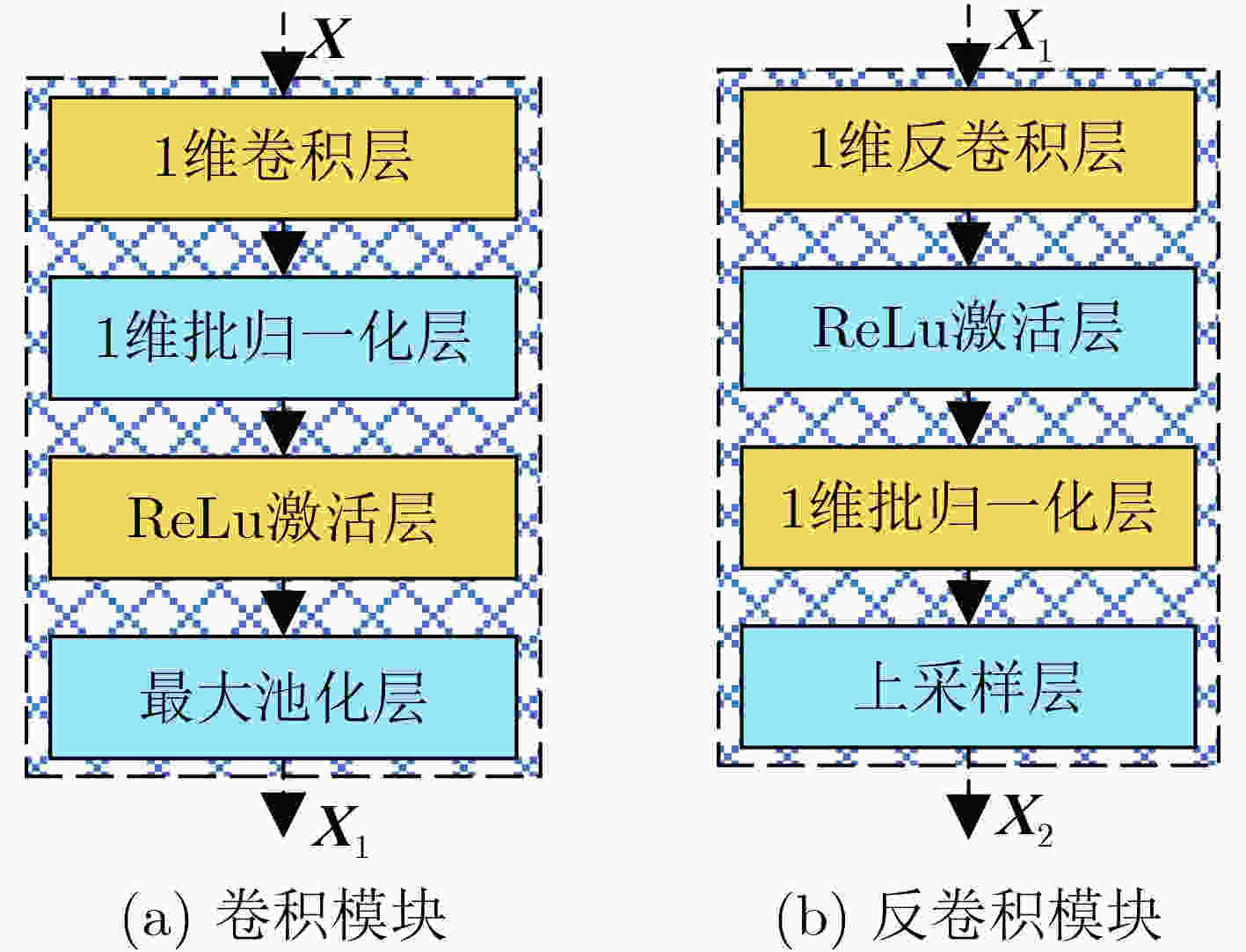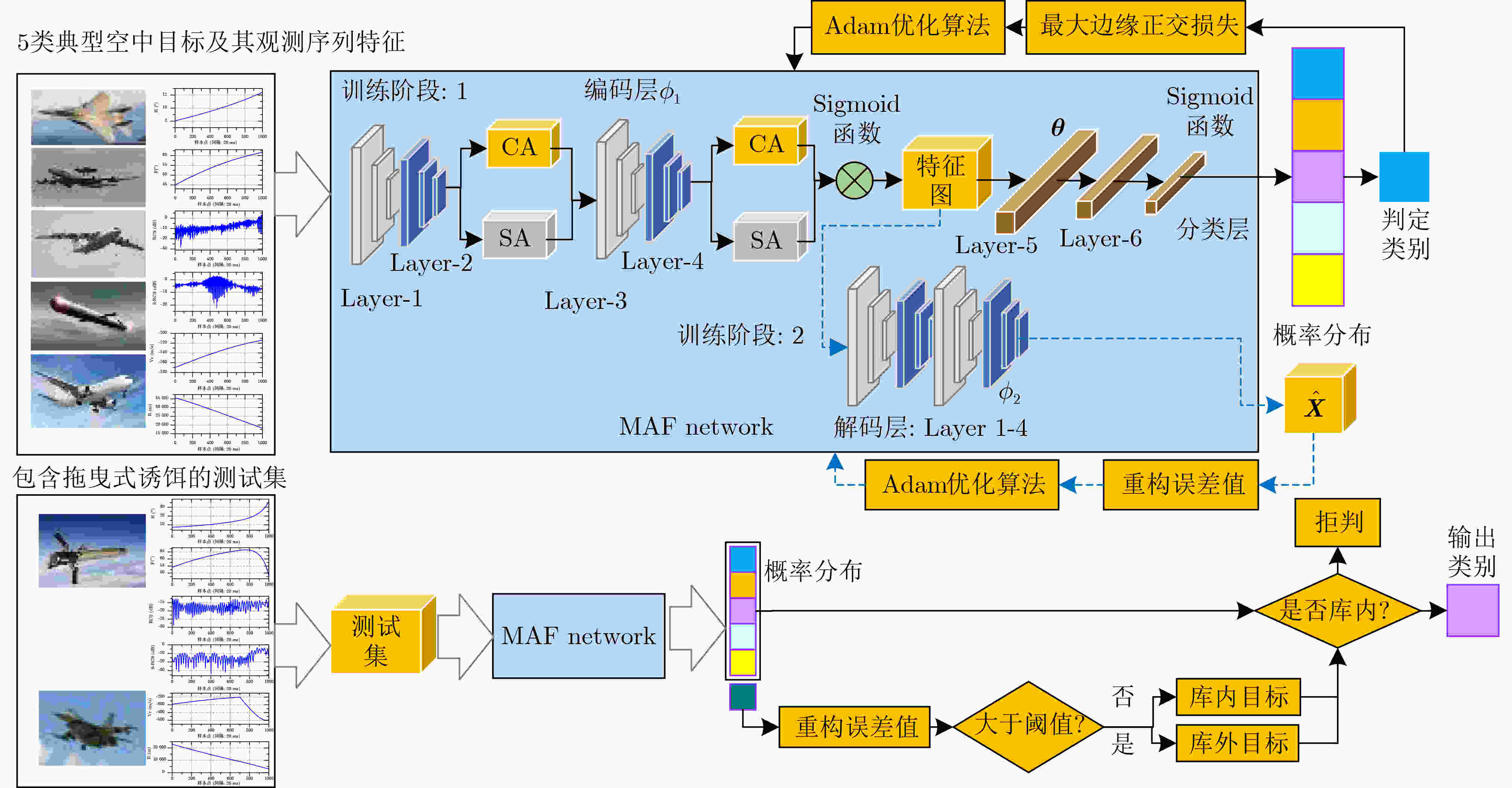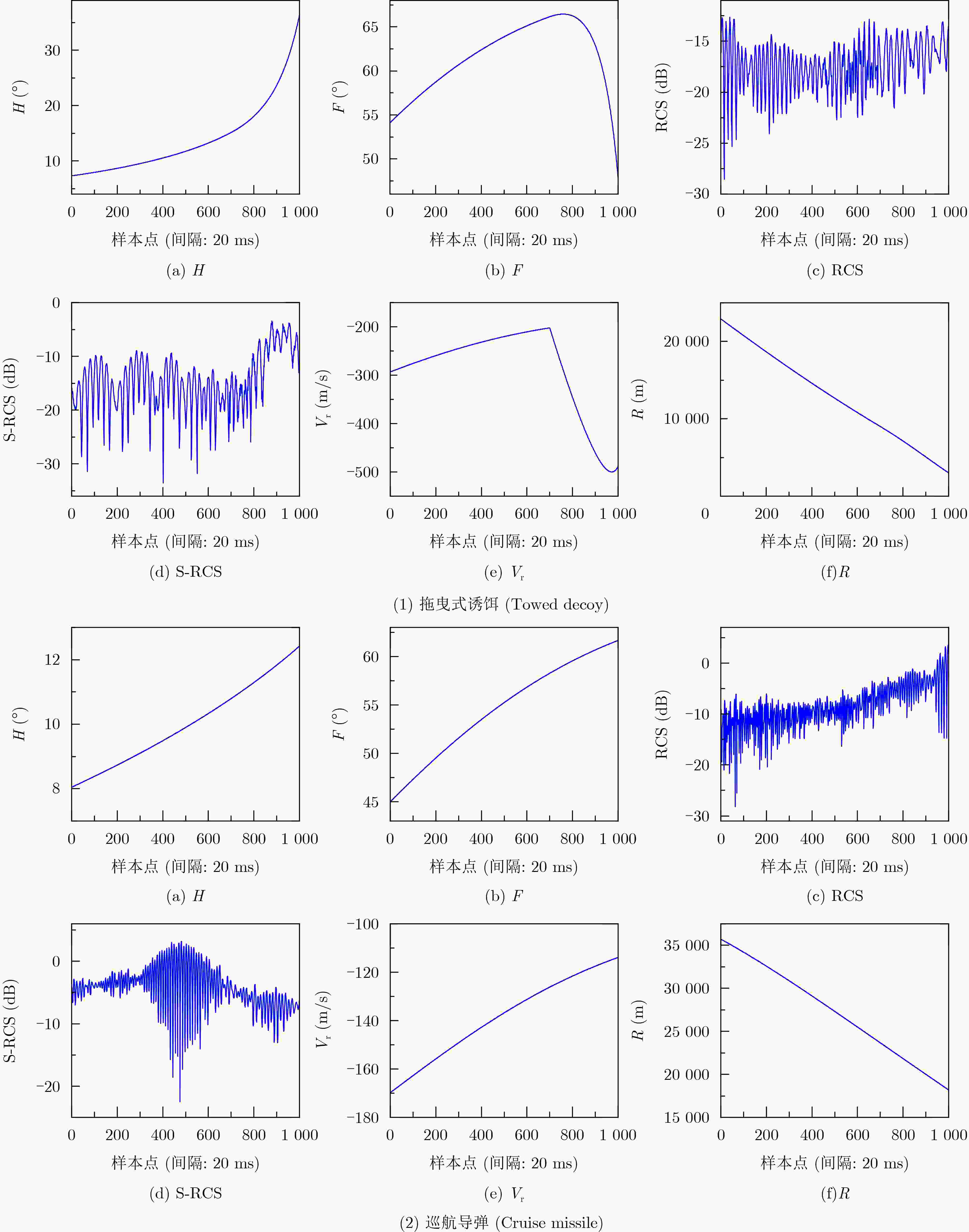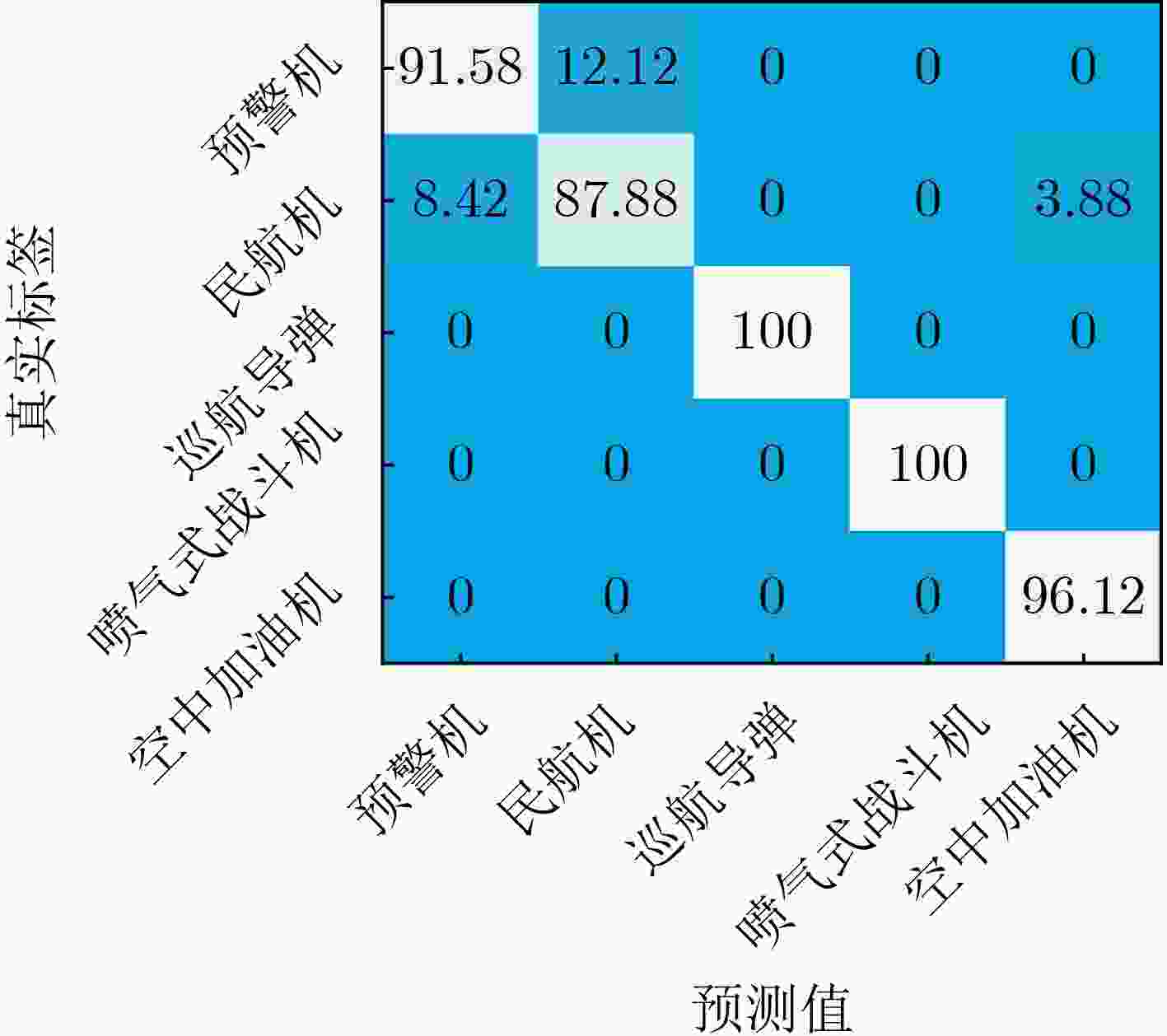Airborne Target Recognition of Narrowband Radar Short Time Observation Echoes Based on Feature Fusion
-
摘要: 窄带雷达因其成本低、作用距离远的优点在防空制导领域有着广泛应用,随着高速机动平台的发展,传统的基于长时间观测回波序列特征建模的目标识别方法已不再适用。针对窄带雷达对短时间观测回波(OEST)序列特征识别能力较差,并且易受诱饵目标干扰,导致识别结果可靠性不高的问题,该文提出一种采用多特征自适应融合的窄带雷达OEST序列空中目标识别方法。首先,对编码层和分类层进行训练,通过构建通道-空间注意力模块,自适应地突出高可分性特征,然后,构建最大边缘正交损失函数,增大不同类别特征间距,缩小同类特征间距,并使类间特征正交,以此提升分类性能;最后,固定编码层与分类层参数,利用重构误差对解码层进行训练,确保模型具备对诱饵等库外目标的准确鉴别能力。实验部分在观测序列长度为100的条件下,分类准确率和鉴别率分别达到94.37%和96.78%,由此可得,所提方法能够有效提升窄带雷达的分类性能和对诱饵目标的鉴别能力,进而提高识别结果的可靠性。Abstract: Narrowband radar is widely used in the field of air defense guidance due to its advantages of low cost and long operating range. With the development of high-speed mobile platforms, traditional target recognition methods based on feature modeling of long-term observation echo sequences are no longer applicable. In response to the problem of poor feature recognition ability of narrowband radar for Observe Echoes for a Short period of Time (OEST) sequences and susceptibility to bait target interference, resulting in low reliability of recognition results, a narrowband radar OEST sequence air target recognition method using multi feature adaptive fusion is proposed in this paper. Firstly, the encoder and classification layers are constructed with channel-spatial attention modules and trained to adaptively enhance features with high separability. Then, the maximum edge orthogonal loss function is proposed to increase the feature spacing between different classes, reduce the feature spacing between the same classes, and make the feature vectors orthogonal between different classes; Finally, the parameters of the encoder layer and classification layer are fixed, and the decoder layer is trained using reconstruction loss value to ensure that the model has accurate identification ability for decoy targets. Under the condition of an observation sequence length of 100, the classification accuracy and discrimination rate of the experimental part reached 94.37% and 96.78%, respectively. It can be concluded that the proposed method can effectively improve the classification performance of narrowband radar and the discrimination ability against bait targets, thereby improving the reliability of recognition results.
-
表 1 鉴别准确率对比
方法 鉴别准确率(%) SVDD 78.03 W-KNN 76.81 Deep-SVDD 91.55 TCNN 82.76 MAF-Net (Ours) 96.78 表 2 分类准确率对比
方法 分类准确率(%) 时间(s) SVM 35.62 0.53 CNN-SVM 86.78 2.86 CNN-KNN 86.59 2.89 LSTM 90.16 3.31 TCNN 88.24 2.94 MAF-Net (Ours) 94.37 2.74 -
[1] 梁复台, 李宏权, 刘安波, 等. 基于CNN的窄带雷达空中目标识别方法[J]. 火力与指挥控制, 2020, 45(6): 85–90. doi: 10.3969/j.issn.1002-0640.2020.06.016.LIANG Futai, LI Hongquan, LIU Anbo, et al. Research on aerial target recognition method for narrow-band radar based on CNN[J]. Fire Control & Command Control, 2020, 45(6): 85–90. doi: 10.3969/j.issn.1002-0640.2020.06.016. [2] CHEN V C, LI Fayin, HO S S, et al. Micro-Doppler effect in radar: Phenomenon, model, and simulation study[J]. IEEE Transactions on Aerospace and Electronic Systems, 2006, 42(1): 2–21. doi: 10.1109/TAES.2006.1603402. [3] 赵越, 陈之纯, 纠博, 等. 一种基于时频分析的窄带雷达飞机目标分类特征提取方法[J]. 电子与信息学报, 2017, 39(9): 2225–2231. doi: 10.11999/JEIT161204.ZHAO Yue, CHEN Zhichun, JIU Bo, et al. Narrowband aircraft targets feature extraction and classification based on time-frequency analysis[J]. Journal of Electronics & Information Technology, 2017, 39(9): 2225–2231. doi: 10.11999/JEIT161204. [4] 王颖. 窄带雷达空中目标识别技术研究[D]. [硕士论文], 西安电子科技大学, 2022. doi: 10.27389/d.cnki.gxadu.2022.002380.WANG Ying. Research on air target recognition technology of narrowband radar[D]. [Master dissertation], Xidian University, 2022. doi: 10.27389/d.cnki.gxadu.2022.002380. [5] 高瑞明, 李明星. 基于调制谱图卷积神经网络的空中目标识别技术[J]. 电光与控制, 2021, 28(2): 59–64. doi: 10.3969/j.issn.1671-637X.2021.02.012.GAO Ruiming and LI Mingxing. Aerial target recognition based on CNN processing of modulation spectrum graphs[J]. Electronics Optics & Control, 2021, 28(2): 59–64. doi: 10.3969/j.issn.1671-637X.2021.02.012. [6] 林青松, 胡卫东, 虞华, 等. 低分辨雷达回波序列轮廓像目标分类方法研究[J]. 现代雷达, 2005, 27(3): 24–28. doi: 10.16592/j.cnki.1004-7859.2005.03.008.LIN Qingsong, HU Weidong, YU Hua, et al. A study of target classification method based on low-resolution radar return sequences image profile[J]. Modern Radar, 2005, 27(3): 24–28. doi: 10.16592/j.cnki.1004-7859.2005.03.008. [7] 梁复台, 李宏权, 张晨浩. 基于深度迁移学习的窄带雷达群目标识别方法[J]. 兵器装备工程学报, 2020, 41(4): 143–147. doi: 10.11809/bqzbgcxb2020.04.028.LIANG Futai, LI Hongquan, and ZHANG Chenhao. Narrowband radar unresolved targets recognition method based on deep transfer learning[J]. Journal of Ordnance Equipment Engineering, 2020, 41(4): 143–147. doi: 10.11809/bqzbgcxb2020.04.028. [8] 狄方旭, 王小平, 林秦颖, 等. 雷达与红外数据融合的近距空中目标识别[J]. 电光与控制, 2014, 21(9): 54–57,75. doi: 10.3969/j.issn.1671-637X.2014.09.012.DI Fangxu, WANG Xiaoping, LIN Qinying, et al. Close aerial target recognition based on data fusion of radar and infrared sensor[J]. Electronics Optics & Control, 2014, 21(9): 54–57,75. doi: 10.3969/j.issn.1671-637X.2014.09.012. [9] 吴强, 姜礼平, 季傲. 基于模糊集和D-S证据理论的空中作战目标识别[J]. 指挥控制与仿真, 2015, 37(4): 54–58. doi: 10.3969/j.issn.1673-3819.2015.04.012.WU Qiang, JIANG Liping, and JI Ao. Aircraft target identification based on fuzzy sets and D-S evidence theory in air operation[J]. Command Control & Simulation, 2015, 37(4): 54–58. doi: 10.3969/j.issn.1673-3819.2015.04.012. [10] 魏文博, 蔡红军. 基于支持向量机的窄带雷达弹道导弹目标识别技术[J]. 电子科技, 2016, 29(6): 75–78. doi: 10.16180/j.cnki.issn1007-7820.2016.06.022.WEI Wenbo and CAI Hongjun. Narrowband radar ballistic missile target recognition technology based on SVM[J]. Electronic Science and Technology, 2016, 29(6): 75–78. doi: 10.16180/j.cnki.issn1007-7820.2016.06.022. [11] GAO Yong, ZHOU Yu, WANG Yan, et al. Narrowband radar automatic target recognition based on a hierarchical fusing network with multidomain features[J]. IEEE Geoscience and Remote Sensing Letters, 2021, 18(6): 1039–1043. doi: 10.1109/LGRS.2020.2993039. [12] TIAN Xudong, BAI Xueru, and ZHOU Feng. Recognition of micro-motion space targets based on attention-augmented cross-modal feature fusion recognition network[J]. IEEE Transactions on Geoscience and Remote Sensing, 2023, 61: 5104909. doi: 10.1109/TGRS.2023.3275991. [13] WAN Jinwei, CHEN Bo, XU Bin, et al. Convolutional neural networks for radar HRRP target recognition and rejection[J]. EURASIP Journal on Advances in Signal Processing, 2019, 2019(1): 5. doi: 10.1186/s13634-019-0603-y. [14] 胡明春, 王建明, 孙俊, 等. 雷达目标识别原理与实验技术[M]. 北京: 国防工业出版社, 2017: 12–13.HU Mingchun, WANG Jianming, SUN Jun, et al. Principle and Experiments of Radar Target Recognition Technology[M]. Beijing: National Defense Industry Press, 2017: 12–13. [15] CHEN Jian, XU Shiyou, and CHEN Zengping. Convolutional neural network for classifying space target of the same shape by using RCS time series[J]. IET Radar, Sonar & Navigation, 2018, 12(11): 1268–1275. doi: 10.1049/iet-rsn.2018.5237. [16] CHEN Jian, XU Shiyou, HU Pengjiang, et al. Precession period extraction of axisymmetric space target from RCS sequence via convolutional neural network[C]. 2018 Progress in Electromagnetics Research Symposium (PIERS 2018), Toyama, Japan, 2018: 2077–2082. doi: 10.23919/PIERS.2018.8597685. [17] TAX D M J and DUIN R P W. Support vector domain description[J]. Pattern Recognition Letters, 1999, 20(11/13): 1191–1199. doi: 10.1016/S0167-8655(99)00087-2. [18] TAX D M J and DUIN R P W. Support vector data description[J]. Machine Learning, 2004, 54(1): 45–66. doi: 10.1023/B:MACH.0000008084.60811.49. [19] PARVIN H, ALIZADEH H, and MINAEI-BIDGOLI B. MKNN: Modified K-nearest neighbor[C]. The World Congress on Engineering and Computer Science 2008, San Francisco, USA, 2008. [20] RUFF L, VANDERMEULEN R A, GÖRNITZ N, et al. Deep one-class classification[C]. The 35th International Conference on Machine Learning, Stockholm, Sweden, 2018: 4393–4402. [21] WIEDERER J, SCHMIDT J, KRESSEL U, et al. A benchmark for unsupervised anomaly detection in multi-agent trajectories[C]. 2022 IEEE 25th International Conference on Intelligent Transportation Systems (ITSC), Macau, China, 2022: 130–137. doi: 10.1109/ITSC55140.2022.9922440. [22] LEE K, MAJI S, RAVICHANDRAN A, et al. Meta-learning with differentiable convex optimization[C]. IEEE/CVF Conference on Computer Vision and Pattern Recognition, Long Beach, USA, 2019: 10649–10657. doi: 10.1109/CVPR.2019.01091. [23] VAN DER MAATEN L and HINTON G. Visualizing data using t-SNE[J]. Journal of Machine Learning Research, 2008, 9(86): 2579–2605. [24] KOBAK D and LINDERMAN G C. Initialization is critical for preserving global data structure in both t-SNE and UMAP[J]. Nature Biotechnology, 2021, 39(2): 156–157. doi: 10.1038/s41587-020-00809-z. -






 下载:
下载:










 下载:
下载:
